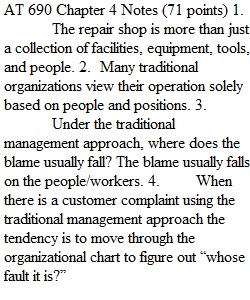


Q AT 690 Chapter 4 Notes (71 points) 1. The repair shop is more than just a collection of _________________, ____________________, ____________ and people. 2. Many traditional organizations view their operation solely based on _______________ and ________________. 3. Under the traditional management approach, where does the blame usually fall? 4. When there is a customer complaint using the traditional management approach the tendency is to move through the organizational chart to figure out “ __________ ___________ _____ _____?” 5. Using this traditional management approach it is a ___________ percent people-focused trail of accountability and blame. 6. On the other hand the _________________ view takes a look at the way things are organized and the way work flows (or fails to flow) that has the greatest effect on performance. 7. What are the three basic components of the system model? (3pts) 8. _______________ are all of the resources required for the system to be able to function. 9. Name eight inputs (information and resources) you might see for a repair shop: (8pts) 10. All of the activities that occur at the repair shop to meet the customer’s needs and wants would be known as the _____________________. 11. The _____________________ of a system are the products or services that the system provides. 12. Name five outputs you might see for a repair shop: (5pts) 13. In the advanced systems model the __________________ loop is added. 14. You cannot make things better unless you know that they are not ______________. 15. By intentionally taking the feedback and funneling it back into the system as an additional input, you create an environment that you can ______________________ and_______________________ make things better each time through the cycle. 16. By acknowledging problems and rapidly resolving them, you can save countless ____________________ and countless dollars in __________________ claims, ________________products and bad __________. 17. Viewing things as a system, which includes all resources that come into play (not just people), it gives you a broader perspective and allows you the opportunity to _________________ and ___________ the root problem. 18. __________________ ____________________ allows you to improve existing systems and design new ones that will flow smoothly and increase productivity. 19. Using systems thinking says that ________ percent of all problems are systems problems and only _______ percent are people problems. 20. Systems thinking is based on looking at the organizational ___________________ and the __________________ required to make the processes within them flow smoothly. 21. The __________________ process takes into account each of the steps that must be completed to move from the ______________ to the _______________. 22. What are the 9 basic steps in the repair process? (9pts) 23. Most shops work on a _________________________ basis. 24. The majority of appointments are made by ________________ but __________-based communication continues to be more widespread offering customers online appointment scheduling. 25. During the ___________________the responsible employee meets and greets the customer and gathers necessary information about needed services and repairs. 26. The _________________ ______________________ step is much more than merely handing out the next repair in the stack of orders. 27. During this step, management needs to maximize their resources by matching up their ______________, their __________________ and their ___________________ to achieve maximum productivity. 28. Work distribution may be done ___________________ using a work-routing system or may be done using a _____________________ system. 29. During the work performance stage the technician _______________ the customers concerns, ____________________ the vehicle and ______________________ the needed repairs. 30. At the work performance stage the technician will often require __________________ information, ____________, _______________, or additional ______________________ from the customer. 31. The technician needs to ______________ the customer concerns were resolved and offer a detailed ______________________ of what was done to resolve the customers concerns. 32. Once the vehicle has been repaired the technician should _______________-check their work. 33. Verification that the repairs performed have resolved the customers concerns are usually performed by a service advisor or shop foreman. This step is known as ________________ _____________________. 34. “The job is not complete until the paperwork is done” refers to the _________________________ step. 35. What are the 3 parts of invoicing? (3pts) 36. If the repairs are performed at a dealership under warranty, who is usually responsible for the Invoicing? 37. The final step of the invoicing is to do what? 38. It is critical for customer satisfaction that during the ________________ step that the customer clearly understands what has been done, what has been approved and what the charges are before being asked to settle the bill. 39. _______________________ is usually the last step of the transaction where the customer has face to face contact with someone at the repair facility. 40. The post-repair activity that is intended to verify that the customer is satisfied is known as the ________________-________ step. 41. The follow-up step is usually performed ___________ to ______________ days after the customer has picked up their car. 42. You can track the workflow through service using what is known as a _______________________. 43. The size of the shop does not affect the number of service ____________, it does affect the _____________ of people that may be involved in those steps. 44. The idea of flowcharting is to help you “__________” how things flow through the repair shop. 45. Graphically portraying the flow of work helps you to __________________ and _________________ problem areas. 46. The flowchart will help you to see where the bottlenecks are and determine whether it is due to a lack of people ______________________ an important task or ___________________. 47. A bottleneck could be caused by too many _______________________, ______________ , _______________ orders or too many ________________ arriving at the same place at the same time.
View Related Questions